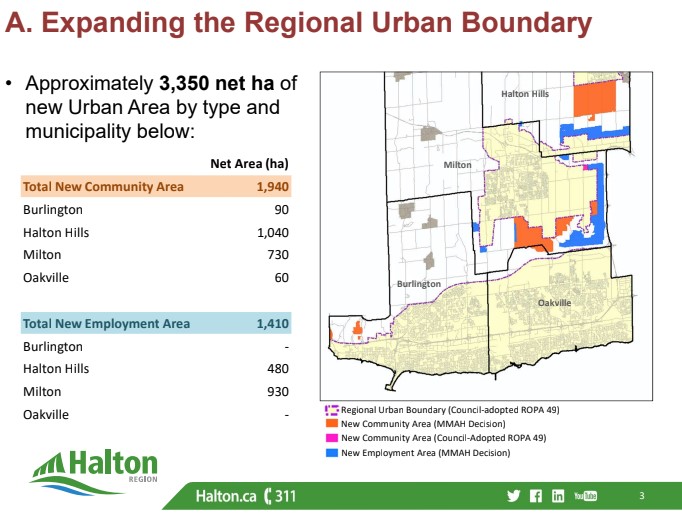
A decision by Halton councillors to freeze the region's urban boundary until at least 2041 has been rejected by the province.
Last spring, after extensive consultation – and in the face of noisy lobbying from "anti-sprawl" groups – regional councillors approved an official plan update.
Read more here: https://oakvillenews.org/news/oakville-burlington-councillors-accused-of-playing-politics-/
Known as Regional Official Plan Amendment 49, or ROPA 49, the plan defined where and how Halton should grow.
Councillors opted to curb new greenfield development until 2041, with a plan to evaluate Halton's land needs from 2041 to 2051. It also required approval from the Ministry of Municipal Affairs and Housing.
Last Friday, the province issued 45 amendments to Halton's plan.
According to Curt Benson, Halton's director of planning services, the changes will expand the region's urban boundary and add about 3,350 net hectares of developable land.
Nearly 2,000 hectares will be used for new residential growth, while about 1,400 will be for employment lands.
Most of the new development lands will be south of Georgetown and outside of Milton, but the provincial amendments add 60 new hectares of urban land to Oakville, in an area north of Hwy 407, outside of the Greenbelt.
The changes will also convert a few small chunks of land designated for employment land to residential use, including about 40 hectares in northeast Oakville.
Oakville councillor Tom Adams asked regional staff to determine who owns the lands in the expanded urban areas.
"It appears to me that there's a whole bunch of developer landowners who have been rewarded for something, and it's really hard to see who those are," he said.
He also expressed concerns over the long-term impact of converting employment lands to residential uses.
"I think it's going to completely gut the entire land use in that area," he said. "It takes out a chunk in the middle of the employment land and converts it, and I think it will destroy the ability of the adjacent lands to house employment."
As a result of the urban expansion, about 10 per cent (3,200 hectares) of the region's existing prime agricultural land will become available for development.

The minister's amendments to ROPA 49 are final and cannot be appealed.
But despite the angst over the provincial changes, the long-term future of the regional plan is uncertain.
Bill 23, the provincial housing legislation introduced on Oct. 25, will eliminate land use planning done at upper-tier municipalities, including Halton.
That would leave the region's four lower-tier municipalities – Oakville, Burlington, Milton and Halton Hills – responsible for all planning.
But whether the regional plan will simply become part of the official plans maintained by each local municipality is still unclear, said Benson.
Stop Sprawl Halton, the group responsible for pressuring regional politicians into the boundary freeze is describing the ROPA 49 amendments as an "assault on municipal democracy."
Those concerns were echoed by Halton Hills councillor Jane Fogel, who spearheaded opposition to an expansion of Halton's urban boundary.
"What this does to our democracy – our whole thing about public input – everybody's got to ask, why are we bothering?"
She added that some of the land added for residential development south of Georgetown doesn't seem to make good planning sense, as it isn't able to be efficiently connected for servicing.
"We're doing development by developer, here," said Fogel.